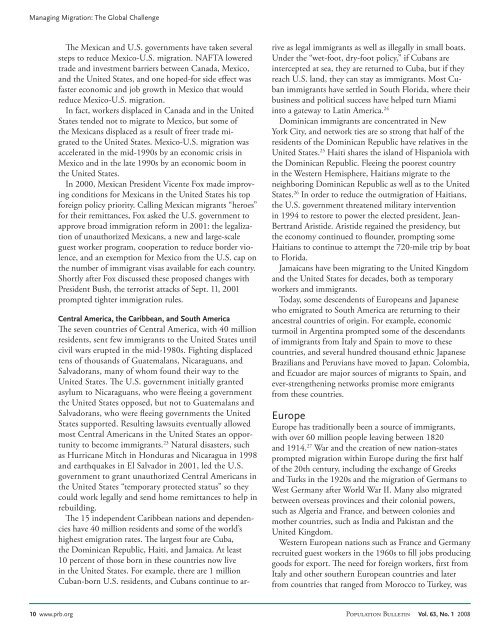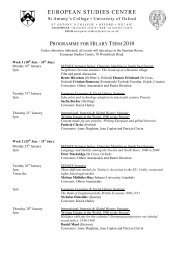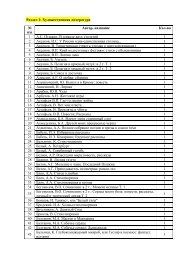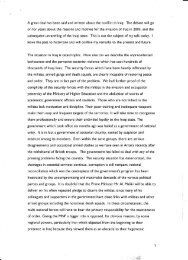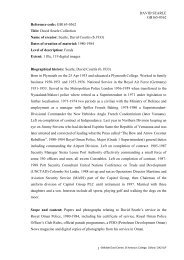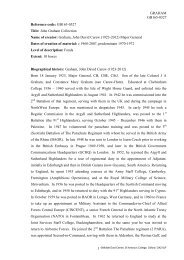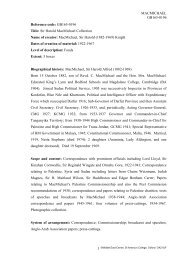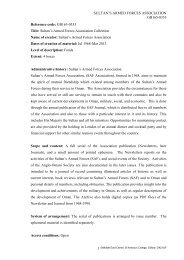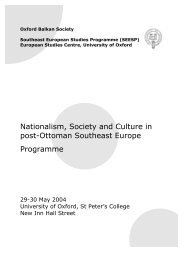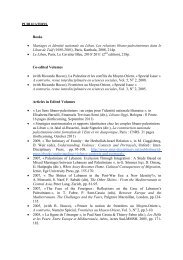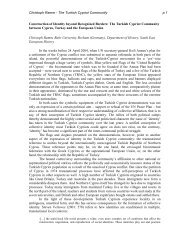Managing Migration: The Global Challenge, Population Bulletin, Vol ...
Managing Migration: The Global Challenge, Population Bulletin, Vol ...
Managing Migration: The Global Challenge, Population Bulletin, Vol ...
You also want an ePaper? Increase the reach of your titles
YUMPU automatically turns print PDFs into web optimized ePapers that Google loves.
<strong>Managing</strong> <strong>Migration</strong>: <strong>The</strong> <strong>Global</strong> <strong>Challenge</strong><br />
<strong>The</strong> Mexican and U.S. governments have taken several<br />
steps to reduce Mexico-U.S. migration. NAFTA lowered<br />
trade and investment barriers between Canada, Mexico,<br />
and the United States, and one hoped-for side effect was<br />
faster economic and job growth in Mexico that would<br />
reduce Mexico-U.S. migration.<br />
In fact, workers displaced in Canada and in the United<br />
States tended not to migrate to Mexico, but some of<br />
the Mexicans displaced as a result of freer trade migrated<br />
to the United States. Mexico-U.S. migration was<br />
accelerated in the mid-1990s by an economic crisis in<br />
Mexico and in the late 1990s by an economic boom in<br />
the United States.<br />
In 2000, Mexican President Vicente Fox made improving<br />
conditions for Mexicans in the United States his top<br />
foreign policy priority. Calling Mexican migrants “heroes”<br />
for their remittances, Fox asked the U.S. government to<br />
approve broad immigration reform in 2001: the legalization<br />
of unauthorized Mexicans, a new and large-scale<br />
guest worker program, cooperation to reduce border violence,<br />
and an exemption for Mexico from the U.S. cap on<br />
the number of immigrant visas available for each country.<br />
Shortly after Fox discussed these proposed changes with<br />
President Bush, the terrorist attacks of Sept. 11, 2001<br />
prompted tighter immigration rules.<br />
Central America, the Caribbean, and South America<br />
<strong>The</strong> seven countries of Central America, with 40 million<br />
residents, sent few immigrants to the United States until<br />
civil wars erupted in the mid-1980s. Fighting displaced<br />
tens of thousands of Guatemalans, Nicaraguans, and<br />
Salvadorans, many of whom found their way to the<br />
United States. <strong>The</strong> U.S. government initially granted<br />
asylum to Nicaraguans, who were fleeing a government<br />
the United States opposed, but not to Guatemalans and<br />
Salvadorans, who were fleeing governments the United<br />
States supported. Resulting lawsuits eventually allowed<br />
most Central Americans in the United States an opportunity<br />
to become immigrants. 23 Natural disasters, such<br />
as Hurricane Mitch in Honduras and Nicaragua in 1998<br />
and earthquakes in El Salvador in 2001, led the U.S.<br />
government to grant unauthorized Central Americans in<br />
the United States “temporary protected status” so they<br />
could work legally and send home remittances to help in<br />
rebuilding.<br />
<strong>The</strong> 15 independent Caribbean nations and dependencies<br />
have 40 million residents and some of the world’s<br />
highest emigration rates. <strong>The</strong> largest four are Cuba,<br />
the Dominican Republic, Haiti, and Jamaica. At least<br />
10 percent of those born in these countries now live<br />
in the United States. For example, there are 1 million<br />
Cuban-born U.S. residents, and Cubans continue to arrive<br />
as legal immigrants as well as illegally in small boats.<br />
Under the “wet-foot, dry-foot policy,” if Cubans are<br />
intercepted at sea, they are returned to Cuba, but if they<br />
reach U.S. land, they can stay as immigrants. Most Cuban<br />
immigrants have settled in South Florida, where their<br />
business and political success have helped turn Miami<br />
into a gateway to Latin America. 24<br />
Dominican immigrants are concentrated in New<br />
York City, and network ties are so strong that half of the<br />
residents of the Dominican Republic have relatives in the<br />
United States. 25 Haiti shares the island of Hispaniola with<br />
the Dominican Republic. Fleeing the poorest country<br />
in the Western Hemisphere, Haitians migrate to the<br />
neighboring Dominican Republic as well as to the United<br />
States. 26 In order to reduce the outmigration of Haitians,<br />
the U.S. government threatened military intervention<br />
in 1994 to restore to power the elected president, Jean-<br />
Bertrand Aristide. Aristide regained the presidency, but<br />
the economy continued to flounder, prompting some<br />
Haitians to continue to attempt the 720-mile trip by boat<br />
to Florida.<br />
Jamaicans have been migrating to the United Kingdom<br />
and the United States for decades, both as temporary<br />
workers and immigrants.<br />
Today, some descendents of Europeans and Japanese<br />
who emigrated to South America are returning to their<br />
ancestral countries of origin. For example, economic<br />
turmoil in Argentina prompted some of the descendants<br />
of immigrants from Italy and Spain to move to these<br />
countries, and several hundred thousand ethnic Japanese<br />
Brazilians and Peruvians have moved to Japan. Colombia,<br />
and Ecuador are major sources of migrants to Spain, and<br />
ever-strengthening networks promise more emigrants<br />
from these countries.<br />
Europe<br />
Europe has traditionally been a source of immigrants,<br />
with over 60 million people leaving between 1820<br />
and 1914. 27 War and the creation of new nation-states<br />
prompted migration within Europe during the first half<br />
of the 20th century, including the exchange of Greeks<br />
and Turks in the 1920s and the migration of Germans to<br />
West Germany after World War II. Many also migrated<br />
between overseas provinces and their colonial powers,<br />
such as Algeria and France, and between colonies and<br />
mother countries, such as India and Pakistan and the<br />
United Kingdom.<br />
Western European nations such as France and Germany<br />
recruited guest workers in the 1960s to fill jobs producing<br />
goods for export. <strong>The</strong> need for foreign workers, first from<br />
Italy and other southern European countries and later<br />
from countries that ranged from Morocco to Turkey, was<br />
10 www.prb.org <strong>Population</strong> <strong>Bulletin</strong> <strong>Vol</strong>. 63, No. 1 2008


